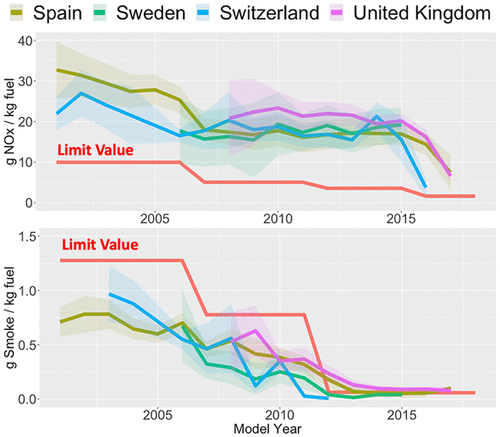当前位置:
X-MOL 学术
›
Environ. Sci. Technol.
›
论文详情
Our official English website, www.x-mol.net, welcomes your
feedback! (Note: you will need to create a separate account there.)
On-Road NOx and Smoke Emissions of Diesel Light Commercial Vehicles-Combining Remote Sensing Measurements from across Europe.
Environmental Science & Technology ( IF 10.8 ) Pub Date : 2020-09-08 , DOI: 10.1021/acs.est.9b07856 Yuche Chen 1 , Ruixiao Sun 1 , Jens Borken-Kleefeld 2
Environmental Science & Technology ( IF 10.8 ) Pub Date : 2020-09-08 , DOI: 10.1021/acs.est.9b07856 Yuche Chen 1 , Ruixiao Sun 1 , Jens Borken-Kleefeld 2
Affiliation

|
Light commercial vehicles (LCVs) account for about 10–15% of road traffic in Europe. There have only been few investigations on their on-road emission performance. Here, on-road remote sensing vehicle emission measurements from 18 locations across four European countries are combined for a comprehensive analysis of NOx and smoke emission rates from diesel LCV in the past two decades. This allows differentiating the performance by emission standards, model years, curb weights, engine loads, manufacturers, vehicle age, and temperature, as well as by measurement devices. We find a general consistency between devices and countries. On-road NOx emission rates have been much higher than type approval limit values for all manufacturers, but some perform systematically better than others. Emission rates have gone down only with the introduction of Euro 6a-b emission standards since the year 2015. Smoke emission rates are considered a proxy for particulate emissions. Their emissions have decrease substantially from the year 2010 onward for all countries and size classes measured. This is consistent with the substantial tightening of the particulate matter emission limit value that typically forced the introduction of a diesel particulate filter. The average NOx emission rate increases with engine load and decreasing ambient temperatures, particularly for Euro 4 and 5 emission classes. This explains to a large extent the differences in the absolute level between the measurement sites together with differences in fleet composition. These dependencies have already been observed earlier with diesel passenger cars; they are considered part of an abnormal emission control strategy. Some limited increase of the NOx emission rate is observed for Euro 3 vehicles older than 10 years. The strong increase for the youngest Euro 6 LCVs might rather reflect technology advances with successively younger models than genuine deterioration. However, the durability of emission controls for Euro 6 vehicles should be better monitored closely. Smoke emission rates continuously increase with vehicle age, suggesting a deterioration of the after-treatment system with use.
中文翻译:

柴油轻型商用车的道路上NOx和烟气排放量-结合欧洲各地的遥感测量结果。
轻型商用车(LCV)约占欧洲道路交通的10%至15%。对其道路排放性能的研究很少。在这里,来自四个欧洲国家/地区的18个地点的公路遥感车辆排放量测量结果相结合,以全面分析过去20年中柴油LCV的NO x和烟气排放率。这样可以通过排放标准,型号年份,路缘重量,发动机负载,制造商,车辆使用年限和温度以及测量设备来区分性能。我们发现设备和国家/地区之间的总体一致性。在道路NO X所有制造商的排放率都远高于型式认可的极限值,但是有些系统地表现要好于其他制造商。自2015年以来,仅随着引入6a-b欧元排放标准,排放量才有所下降。烟雾排放量被认为是微粒排放的替代物。从2010年开始,对于所有国家和所测量的尺寸等级,其排放量已大幅减少。这与典型地迫使引入柴油机微粒过滤器的微粒物质排放极限值的显着收紧相一致。平均NO x排放率随发动机负载和环境温度的降低而增加,尤其是对于欧4和欧5排放类别。这在很大程度上解释了测量地点之间绝对水平的差异以及车队组成的差异。这些依赖性已经在较早的柴油乘用车中观察到了。它们被认为是异常排放控制策略的一部分。NO x的增加有限观察到10年以上的Euro 3车辆的排放率。最年轻的Euro 6轻型商用车的强劲增长可能反映出技术的进步,其后继的年轻车型而非真正的退化。但是,应密切监控欧元6车辆排放控制的耐久性。烟尘排放量随着车辆的使用年限而持续增加,这表明使用后处理系统会变差。
更新日期:2020-10-06
中文翻译:

柴油轻型商用车的道路上NOx和烟气排放量-结合欧洲各地的遥感测量结果。
轻型商用车(LCV)约占欧洲道路交通的10%至15%。对其道路排放性能的研究很少。在这里,来自四个欧洲国家/地区的18个地点的公路遥感车辆排放量测量结果相结合,以全面分析过去20年中柴油LCV的NO x和烟气排放率。这样可以通过排放标准,型号年份,路缘重量,发动机负载,制造商,车辆使用年限和温度以及测量设备来区分性能。我们发现设备和国家/地区之间的总体一致性。在道路NO X所有制造商的排放率都远高于型式认可的极限值,但是有些系统地表现要好于其他制造商。自2015年以来,仅随着引入6a-b欧元排放标准,排放量才有所下降。烟雾排放量被认为是微粒排放的替代物。从2010年开始,对于所有国家和所测量的尺寸等级,其排放量已大幅减少。这与典型地迫使引入柴油机微粒过滤器的微粒物质排放极限值的显着收紧相一致。平均NO x排放率随发动机负载和环境温度的降低而增加,尤其是对于欧4和欧5排放类别。这在很大程度上解释了测量地点之间绝对水平的差异以及车队组成的差异。这些依赖性已经在较早的柴油乘用车中观察到了。它们被认为是异常排放控制策略的一部分。NO x的增加有限观察到10年以上的Euro 3车辆的排放率。最年轻的Euro 6轻型商用车的强劲增长可能反映出技术的进步,其后继的年轻车型而非真正的退化。但是,应密切监控欧元6车辆排放控制的耐久性。烟尘排放量随着车辆的使用年限而持续增加,这表明使用后处理系统会变差。











































 京公网安备 11010802027423号
京公网安备 11010802027423号